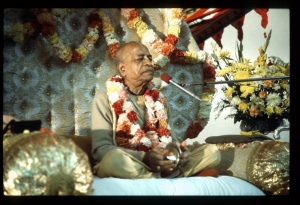CC Madhya 4.104 (1975)

A.C. Bhaktivedanta Swami Prabhupada
Below is the 1996 edition text, ready to be substituted with the 1975 one using the compile form.
TEXT 104
- sei dui śiṣya kari’ sevā samarpila
- rāja-sevā haya,—purīra ānanda bāḍila
SYNONYMS
sei dui—these two persons; śiṣya kari’—initiating; sevā—with the service; samarpila—entrusted; rāja-sevā—gorgeous performance of service; haya—is; purīra—of Mādhavendra Purī; ānanda—pleasure; bāḍila—increased.
TRANSLATION
These two were then initiated by Mādhavendra Purī, and he entrusted them with the daily service of the Lord. This service was performed continuously, and the worship of the Deity became very gorgeous. Thus Mādhavendra Purī was very pleased.
PURPORT
The six Gosvāmīs and their followers started many temples, including the temples of Govinda, Gopīnātha, Madana-mohana, Rādhā-Dāmodara, Śyāmasundara, Rādhā-ramaṇa and Gokulānanda. The disciples of the Gosvāmīs were entrusted with the sevā-pūjā (Deity worship) of these temples. It was not that the disciples were family members of the original Gosvāmīs. All the Gosvāmīs were in the renounced order of life, and Jīva Gosvāmī in particular was a lifelong brahmacārī. At present, sevāitas assume the title of gosvāmī on the basis of their being engaged as sevāitas of the Deity. The sevāitas who have inherited their positions now assume proprietorship of the temples, and some of them are selling the Deities’ property as if it were their own. However, the temples did not originally belong to these sevāitas.